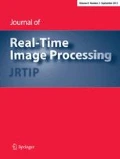Abstract
Fuzzy inference systems always suffer from the lack of efficient structures or platforms for their hardware implementation. In this paper, we tried to overcome this difficulty by proposing a new method for the implementation of the fuzzy rule-based inference systems. To achieve this goal, we have designed a multi-layer neuro-fuzzy computing system based on the memristor crossbar structure by introducing a new concept called the fuzzy minterm. Although many applications can be realized through the use of our proposed system, in this study we only show how the fuzzy XOR function can be constructed and how it can be used to extract edges from grayscale images. One main advantage of our memristive fuzzy edge detector (implemented in analog form) compared to other commonly used edge detectors is it can be implemented in parallel form, which makes it a powerful device for real-time applications.






Similar content being viewed by others
References
Versace, M., Chandler, B.: The brain of a new machine. IEEE Spectr. 47(12), 30–37 (2010)
Cioffi, J.M.: Limited-precision effects in adaptive filtering. IEEE Trans. Circuits. Syst. CAS-34(7), 821–833 (1987)
Haykin, S.: Adaptive Filter Theory, second edn. Prentice-Hall, Englewood Cliffs (1991)
Treichler, J.R., Johnson, C.R., Larimore, M.G.: Theory and Design of Adaptive Filters. Wiley, New York (1987)
Williams, R.S.: How we found the missing memristor. IEEE Spectr. 45(12), 28–35 (2008)
Strukov, D.B., Snider, G.S., Stewart, D.R., Williams, R.S.: The missing memristor found. Nature 453, 80–83 (2008)
Chua, L.O.: Memristor—the missing circuit element. IEEE Trans. Circuit Theory CT-18(5), 507–519 (1971)
Pershin, Y.V., Fontaine, S.L., Ventra, M.D.: Memristive model of amoeba’s learning. Phys. Rev. E 80, 021926 (2009)
Pershin, Y.V., Ventra, M.D.: Practical approach to programmable analog circuits with memristors. IEEE Trans. Circuits Syst. I: Regular Paper 57(8), 1857–1864 (2010)
Merrikh-bayat, F., Shouraki, S.B.: Memristorbased circuits for performing basic arithmetic operations. Procedia Comput. Sci. J. 3, 128–132 (2011)
Merrikh-bayat, F., Shouraki, S.B.: Memristor crossbar-based hardware implementation of IDS method. IEEE Trans. Fuzzy Syst. 19(6), 1083–1096 (2011)
Kuekes, P.: Material implication: digital logic with memristors. In: Memristor and Memristive Systems Symposium, 21 November 2008
Mouttet, B.L.: Proposal for memristors in signal processing. In: Nano-Net Conference, vol. 3, pp. 11–13, Sept 2008
Merrikh-Bayat, F., Shouraki, S.B.: Mixed analog–digital crossbar-based hardware implementation of sign–sign LMS adaptive filter. Analog Integr. Circuits Signal Process 3(1), 41–48 (2011)
Snider, G., Amerson, R., Carter, D., Abdalla, H., Qureshi, M.S., Leveille, J., Versace, M., Ames, H., Patrick, S., Chandler, B., Gorchetchnikov, A., Mingolla, E.: From synapses to circuitry: using memristive memory to explore the electronic brain. IEEE Comput. 44(2), 21–28 (2011)
Afifi, A., Ayatollahi, A., Raissi, F.: Implementation of biologically plausible spiking neural network models on the memristor crossbar-based CMOS/nano circuits. In: European Conference on Circuit Theory and Design (ECCTD 2009), pp. 563–566 (2009)
Snider, G.S.: Spike-timing-dependent learning in memristive nanodevices. In: IEEE International Symposium on Nanoscale Architectures (NANOARCH 2008), pp. 85–92, 12–13 June 2008
McCulloch, W., Pitts, W.: A logical calculus of ideas immanent in nervous activity. Bull. Math. Biophys. 5, 115–133 (1943)
Fausett, L.: Neural Networks: Architectures, Algorithms and Applications. Prentice Hall, Englewood Cliffs (1994)
Biolek, D., Biolek, Z., Biolkova, V.: SPICE modeling of memristive, memcapacitative and meminductive systems. In: European Conference on Circuit Theory and Design (ECCTD2009), pp. 249–252, Antalya, 23–27 August 2009
Canny, J.: A computational approach to edge detection. IEEE Trans. Pattern Anal. Mach. Intell. 8(6), 679–698 (1986)
Mamdani, E.H., Assilian, S.: An experiment in linguistic synthesis with a fuzzy logic controller. Int. J. Man Mach. Stud. 7(1), 1–13 (1975)
Sugeno, M., Kang, G.T.: Structure identification of fuzzy model. Fuzzy Sets Syst. 28, 15–33 (1988)
Takagi, T., Sugeno, M.: Fuzzy Identification of systems and its applications to modeling and control. IEEE Trans. Syst. Man Cybern. 15, 116–132 (1985)
Snider, G., Williams, R.S.: Nano/CMOS architectures using a field-programmable nanowire interconnect. Nanotechnology 18(3), 035204 (2007)
Acknowledgments
The authors thank the anonymous reviewers for suggesting many useful comments to improve the quality of this work.
Author information
Authors and Affiliations
Corresponding author
Rights and permissions
About this article
Cite this article
Merrikh-Bayat, F., Bagheri Shouraki, S. & Merrikh-Bayat, F. Memristive fuzzy edge detector. J Real-Time Image Proc 9, 479–489 (2014). https://doi.org/10.1007/s11554-012-0254-9
Received:
Accepted:
Published:
Issue Date:
DOI: https://doi.org/10.1007/s11554-012-0254-9




